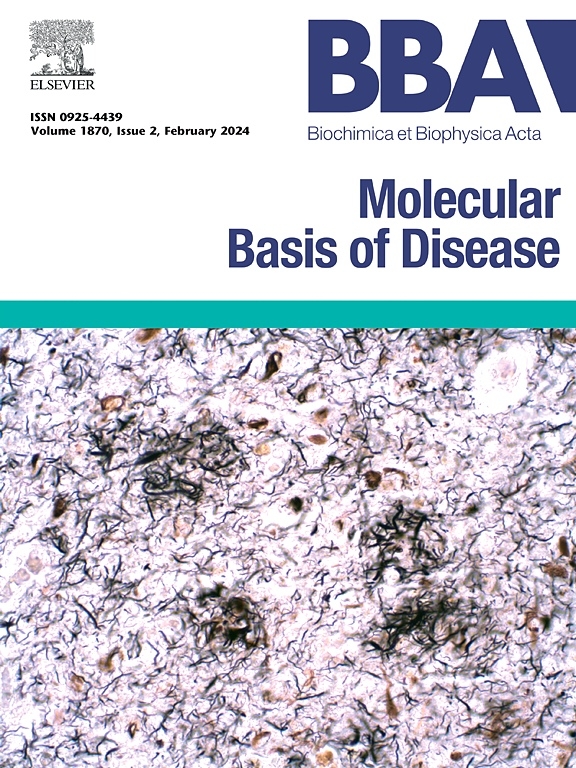Bilirubin nanoparticles modulate Treg/Th17 cells and functional metabolism of gut microbiota to inhibit lung adenocarcinoma
IF 4.2
2区 生物学
Q2 BIOCHEMISTRY & MOLECULAR BIOLOGY
Biochimica et biophysica acta. Molecular basis of disease
Pub Date : 2024-12-23
DOI:10.1016/j.bbadis.2024.167641
引用次数: 0
Abstract
The level of serum bilirubin is associated with the incidence of lung cancer in both smokers and non-smokers, but the specific mechanism is unknown. Bilirubin nanoparticles (BRNPs) were synthesized to explore the effects on Treg/Th17 immunity and gut microbiota in Lewis Lung Carcinoma (LLC) mice, to provide insights for the treatment of lung adenocarcinoma. 10 μg/mL BRNPs promoted apoptosis of A549, NCI-H1299 and LLC cells. BRNPs inhibited lung adenocarcinoma formation in smoking and non-smoking LLC mice. In vivo and in vitro co-culture system proved that BRNPs promoted apoptosis of LLC cells and Treg cell differentiation, and inhibited the cigarette smoke extract (CSE)-induced anti-apoptosis effect and Th17 cell differentiation. In non-smoking LLC mice, Clostridium_sp and Alistipes_inops may be the pathogenic strains for inflammatory infiltration, while Staphylococcus, bile acid, alanine, and glucose metabolism may serve as the therapeutic target in BRNPs group. Fecal supernatant from NPs mice could promote Th17 differentiation and anti-apoptotic effect of LLC cells, while blocking the in vitro pro-apoptotic effect of BRNPs. Helicobacter_rodentium, Streptococcus_salivarius and Bifidobacterium_bifidum and metabolism (lipopolysaccharide and linoleic acid, as well as TCA circulation) may be the potential target for BRNPs+smoke treatment. Fecal supernatant from NPs + smoke mice promoted the CSE-induced Th17 differentiation and the anti-apoptotic effect of LLC cells, but this effect was blocked after the BRNPs intervention. Thus, BRNPs promoted Treg/Th17 cell immunity to inhibit tumor development in both smoking and non-smoking LLC mice through gut microbiota. In addition, BRNPs' therapeutic effect in smoking LLC mice may be related to Helicobacter_rodentium, Streptococcus_salivarius and Bifidobacterium_bifidum.

胆红素纳米颗粒调节Treg/Th17细胞和肠道微生物群的功能代谢抑制肺腺癌。
血清胆红素水平与吸烟者和非吸烟者的肺癌发病率相关,但具体机制尚不清楚。合成胆红素纳米颗粒(BRNPs),探讨其对Lewis肺癌(LLC)小鼠Treg/Th17免疫和肠道微生物群的影响,为肺腺癌的治疗提供新的思路。10 μg/mL BRNPs促进A549、NCI-H1299和LLC细胞凋亡。BRNPs抑制吸烟和不吸烟LLC小鼠肺腺癌的形成。体内和体外共培养系统证明BRNPs促进LLC细胞凋亡和Treg细胞分化,抑制香烟烟雾提取物(CSE)诱导的抗凋亡作用和Th17细胞分化。在不吸烟的LLC小鼠中,Clostridium_sp和Alistipes_inops可能是炎症浸润的致病菌株,而在BRNPs组中,葡萄球菌、胆酸、丙氨酸和糖代谢可能是治疗靶点。NPs小鼠粪便上清可促进LLC细胞Th17分化和抗凋亡作用,而阻断BRNPs的体外促凋亡作用。啮齿螺杆菌、唾液链球菌和两歧双歧杆菌及其代谢(脂多糖和亚油酸,以及TCA循环)可能是BRNPs+烟雾治疗的潜在靶点。NPs + 烟雾小鼠粪便上清可促进cse诱导的Th17分化和LLC细胞的抗凋亡作用,但BRNPs干预后这种作用被阻断。因此,BRNPs促进Treg/Th17细胞免疫,通过肠道菌群抑制吸烟和不吸烟LLC小鼠的肿瘤发展。此外,BRNPs对吸烟LLC小鼠的治疗作用可能与幽门螺杆菌、唾液链球菌和两歧双歧杆菌有关。
本文章由计算机程序翻译,如有差异,请以英文原文为准。
求助全文
约1分钟内获得全文
求助全文
来源期刊
CiteScore
12.30
自引率
0.00%
发文量
218
审稿时长
32 days
期刊介绍:
BBA Molecular Basis of Disease addresses the biochemistry and molecular genetics of disease processes and models of human disease. This journal covers aspects of aging, cancer, metabolic-, neurological-, and immunological-based disease. Manuscripts focused on using animal models to elucidate biochemical and mechanistic insight in each of these conditions, are particularly encouraged. Manuscripts should emphasize the underlying mechanisms of disease pathways and provide novel contributions to the understanding and/or treatment of these disorders. Highly descriptive and method development submissions may be declined without full review. The submission of uninvited reviews to BBA - Molecular Basis of Disease is strongly discouraged, and any such uninvited review should be accompanied by a coverletter outlining the compelling reasons why the review should be considered.

 求助内容:
求助内容: 应助结果提醒方式:
应助结果提醒方式:


